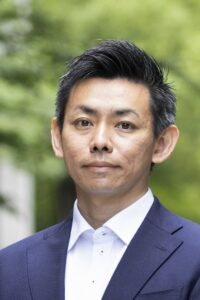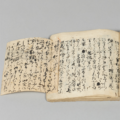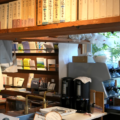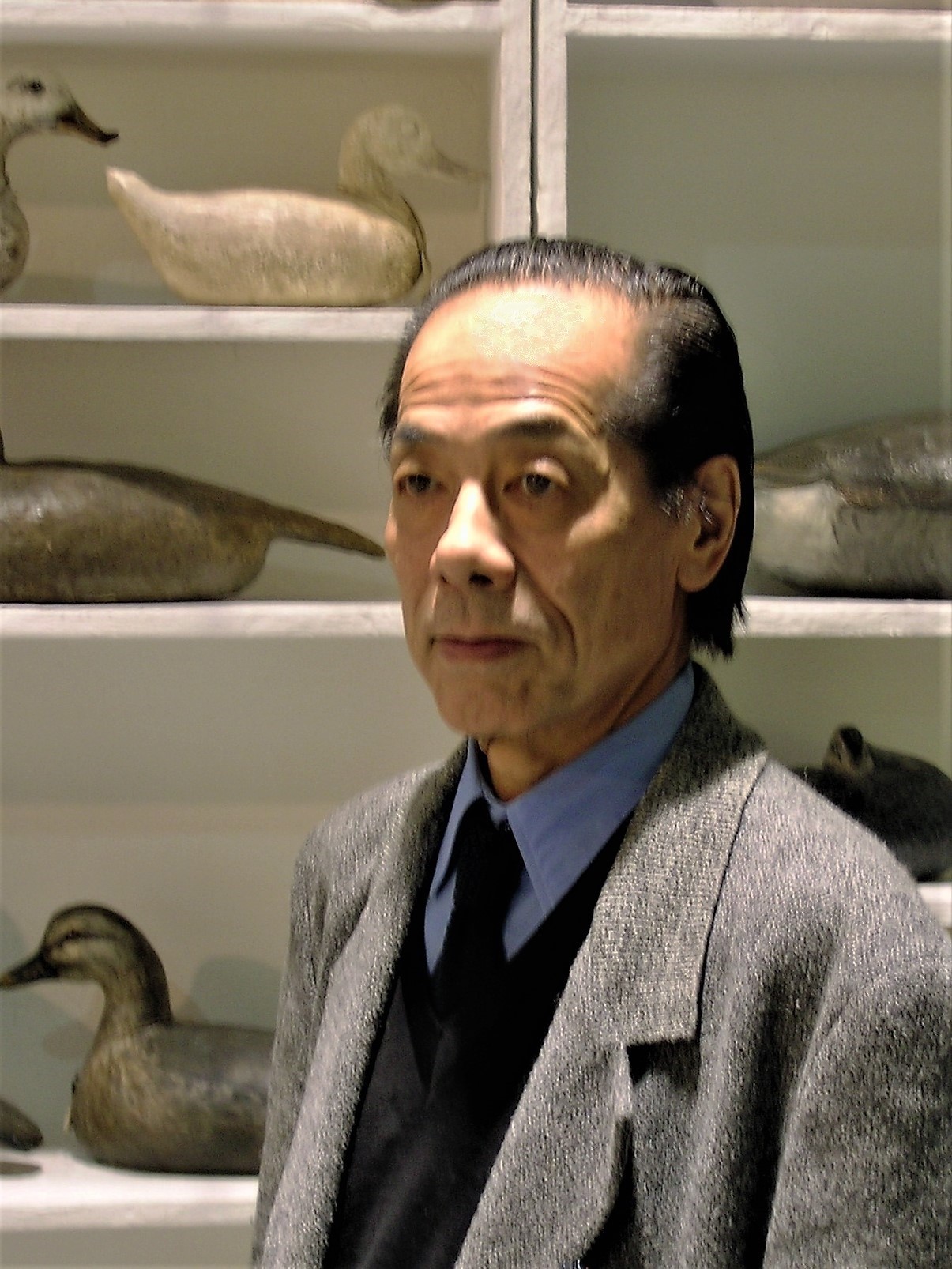Why were the courtesans painted? — After seeing “Special Exhibition: Yoshiwara”
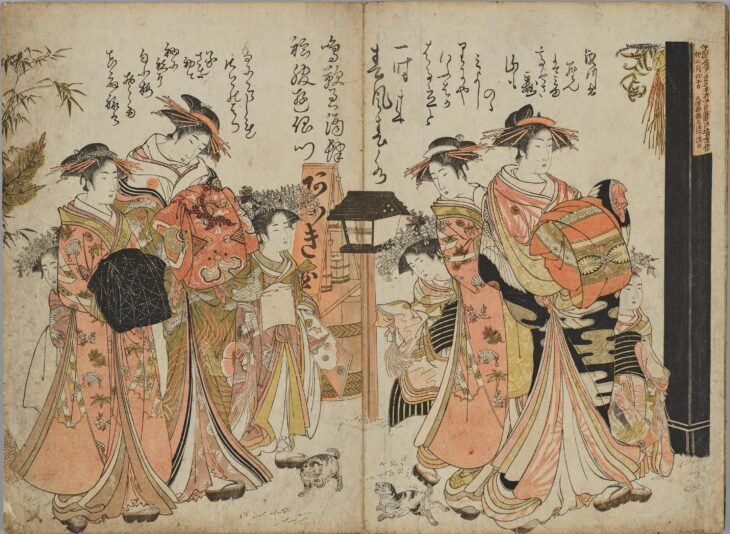
Yoshiwara-keisei Shin-bijin-awase Jihitsu-kagami (Contest of New Yoshiwara Courtesans with Samples of Their Calligraphy) features carvings of the courtesans’ handwritten kyoka and poems, which serve as a form of advertising for the courtesans’ high level of education. The famous courtesans “Hanaogi” and “Takigawa” from that time are depicted. Source: ColBase (https://colbase.nich.go.jp/)
From March 26 to May 19, 2024, the “Special Exhibition: Yoshiwara” was held at the University Art Museum, Tokyo University of the Arts. About 89,900 people visited the museum, and the catalog sold out. It was a great success.
The author visited the exhibition on April 16. The huge exhibition of about 230 works included works by many famous artists such as Hishikawa Moronobu (1618?–1694), Hanabusa Itcho (1652–1724), Kitagawa Utamaro (1753–1806), Chobunsai Eishi (1756–1829), Utagawa Kunisada (1786–1865) and others. The exhibition includes works by famous ukiyo-e artists such as Katsushika Hokusai (1760–1849), Sakai Hoitsu (1761–1829), Takahashi Yuichi (1828–1894) and Kaburaki Kiyokata (1878–1972). The author was overwhelmed by the amount of material and the fact that Yoshiwara had been painted by so many artists, and at the same time, recalls feeling confused and unsure of how to interpret the exhibition. Why is there such a large number of works depicting Yoshiwara?
Amid the controversy surrounding the “Special Exhibition: Yoshiwara”
Even before the exhibition took place, there was a firestorm on social media about this exhibition and it attracted a lot of attention. The original official website had the subtitle “Edo Amazing” and slogans such as “The coolest people were in Yoshiwara!” and “I love entertainment!” In addition, an experience session was planned in which “the entire exhibition hall would be used to recreate Yoshiwara’s Gochomachi (the five cities that made up Yoshiwara),” and an “Odaijin (Big Spender) Night” was also planned, which would include an Oiran Dochu (Procession of Courtesans [oiran means high-ranking courtesan]) as a VIP ticket. These factors led to a flurry of criticism that the exhibition was trying to make invisible the fact that Yoshiwara was a place of human trafficking and sexual exploitation, and to beautify the pleasure district from the buyer’s point of view.
In response to the outrage, the organizers released a document on February 8 entitled “Regarding the Holding of ‘Special Exhibition: Yoshiwara,’” “the ‘Yoshiwara’ pleasure district was built on the sacrifice of courtesans, who were forced into service to repay their debts and could not leave of their own free will. This is a violation of human rights and abuse of women, and is an unforgivable system. This exhibition will be based on the negative history of discrimination against women, which must never be repeated,” read a statement. The website design and content were also changed, and a statement by academic advisor of this Exhibition, Tanaka Yuko, “On holding ‘Special Exhibition: Yoshiwara’ — Yoshiwara and Women’s Human Rights,” was displayed at the press preview and at the exhibition site. The captions and catalog of the exhibition were probably revised slightly, and there were some descriptions of the reality of sex trafficking and courtesans.
However, such descriptions were merely scattered throughout the exhibition, and did not clearly define the images. The author’s honest impression after viewing the exhibition was that it did not reflect the premise of the exhibition, namely, “While sympathizing with the prostitutes depicted in the works, this is an opportunity to reconsider the culture and history of Yoshiwara, which would not have existed without the prostitutes who were sacrificed to the system.” (Introduction to the Catalog).
The problem is not whether the sex trade was mentioned or not. Rather, it lies in the positioning of Yoshiwara’s “culture,” which was the subject of this exhibition. The author discusses his thoughts on this point below.
What was the Yoshiwara painted for?
What the author found most frustrating while viewing the exhibition was that although the phrase “Yoshiwara spread culture” was used many times, until the end of the exhibition it was unclear who spread this culture or what its effects were on whom. In my opinion, when looking at a cultural phenomenon, it is necessary to consider the actors responsible for that culture and the social function of that culture. Considering these things leads to clarifying how that culture is positioned within society. It seems that this exhibition lacked such a structural understanding.
For example, the exhibition explains how Tsutaya Juzaburo (1750–1797) and Kitagawa Utamaro received favorable reviews for their publications on Yoshiwara, “okubi-e”[1] (close-up portraits). But why were these portraits painted? The exhibition commentary explained in detail “how” they were painted, but I felt that very little was said about “why” they were painted. This exhibition is an art exhibition, not a museum exhibition, but it is impossible to explain why such a large number of works depicted Yoshiwara without asking “what” they were painted for.
In fact, a close reading of the catalog reveals that brothels and courtesans were involved in many of the paintings. For example, for Tsutaya Juzaburo’s publications, funds were solicited in advance from brothels and courtesans as gifts for customers, and the ranking lists (printed materials) introducing annual events such as Tamagiku doro (Tamagiku lantern festival)[2] and niwaka (masquerade or costume parade)[3] functioned as advertisements (Catalog, p. 162). Many of the paintings shown in this exhibition have the names of giro (high-class brothels) and courtesans written on them. These are called nyuginmono[4], which means that the owner of the giro or a familiar customer sponsored the painting, or that the courtesans themselves sponsored the painting (Catalog, p. 46, p. 288). In some cases, the crest of the shop is clearly drawn on the noren curtains of the chaya (courtesan teahouse) (Catalog, p. 245). In other words, a significant portion of these paintings were created for the purpose of advertising and promoting the brothels or courtesans, and served to attract customers to the pleasure district.
The same could be said about the culture and fashion of the courtesans. Both courtesans “Hanaogi” and “Takigawa” of the brothel “Ogiya” were famous calligraphers of their time, but it was the plan of the owner of Ogiya to let them study under a calligrapher. The owner of the brothel (roshu) also used various other schemes, such as making Takigawa and Hanaogi compete with each other in the number of customers. As a result, Takigawa became a famous courtesan on a par with Hanaogi, and Ogiya became wealthy (Catalog, p. 167 and Kumo no Itomaki [The Spider’s Reel], 1846). This anecdote shows that the culture of the courtesans was indeed a sales strategy to attract customers. Yoshiwara-keisei Shin-bijin-awase Jihitsu-kagami (Contest of New Yoshiwara Courtesans with Samples of Their Calligraphy) features carvings of the courtesans’ handwritten kyoka[5] and poems, which serve as a form of advertising for the courtesans’ high level of education. This was possible because the work was produced with the support of Yoshiwara (Catalog, p. 166, p. 220).
This exhibition provides an in-depth look at how the fashion of courtesans attracted people’s attention and spread throughout Edo. From the middle of the 17th century, as wage work (manual sideline work) became more common and women’s disposable income increased, it is undoubtedly true that courtesans became a fashion model for ordinary women (Wakita Haruko and Susan B. Hanley, eds., Jenda no Nihon shi [The History of Gender in Japan], Vol. 2, Yokota Fuyuhiko, ‘Joshi Daigaku’ Saiko—Nihonkinsei no josei rodo [Rethinking ‘Women’s University’ — Women’s Labor in Early Modern Japan]). On the other hand, it should not be overlooked that the courtesans’ sense of publicity was also at work here, as the courtesan “Katsuyama”[6] invented new hairstyles and scarlet crepe futanos (loincloths), and the courtesans used hair accessories to demonstrate their high status (Catalog, pp. 222, 234).
What was painted, what was not painted
In this way, much of what this exhibition calls Yoshiwara culture actually functioned to promote the sex trade. This is precisely why so many paintings related to Yoshiwara have survived. Although the commentary gives such important hints, it does not delve into these aspects, but moves on to the excellent skills of Tsutaya Juzaburo and the characteristics of Utamaro’s and Chobunsai Eishi’s portraits of beautiful women. As for Takahashi Yuichi’s Oiran (Courtesan), some have placed it in the light of the public relations strategies of influential brothels during the early Meiji period (1868–1912) of “bunmei kaika” (civilization and enlightenment) (National Museum of Japanese History Special Exhibition “The History of Gender in Japan,” catalog, pp. 196, 2020), while this exhibition emphasizes the fashion depicted and Takahashi Yuichi’s thorough rendering of texture (Catalog, p. 78).
Even before the opening of this exhibition, it was pointed out that the parties involved were not visible and the aspects of the sex trade were not clear, and the author had the same impression when he saw the actual exhibition. This was probably due to the attitude of not dealing with any of the important points mentioned above.
By considering the connection between culture and sex trafficking as a premise, it is possible to see what was and was not depicted in the paintings. As is clear from viewing the entire exhibition, only the most famous courtesans were depicted in the paintings. This can be explained by the way the giros, courtesans, and patrons sponsored the paintings. On the other hand, the works in this exhibition (except for the maps) do not depict kashimise brothels (low-class) or the lower-class courtesans who worked there. The catalog also states that “the harsh working conditions of lower-class courtesans were well known, but they were rarely depicted in ukiyo-e” (p. 63), and “‘kogoshi’ brothels (low-class) and ‘tsubonemise’ brothels (the lowest-class) are not depicted in a single nishiki-e[7]” (p. 111). However, this is a very important point when considering the characteristics of Yoshiwara depicted in ukiyo-e. By examining what was and was not depicted in ukiyo-e, it should be possible to clarify the fantasies that people had and wanted to have about Yoshiwara, and this exercise would certainly have been in line with the aim of the exhibition.
Culture and sex trafficking
In the above statement by Tanaka Yuko, she says, “When looking at the Pleasure District, we must understand both its character as a place where Japanese culture was concentrated and spread, and the fact that it was based on prostitution.” The assertion that one should understand “both” the culture and the sex trade in the pleasure district “simultaneously” is probably true. But was that really what the exhibition was about? In the end, the exhibition seemed to deal only with culture, perhaps because it did not confront the inseparable relationship between the two.
This stance is manifested as an attitude that seeks to treat culture and the sex trade as separate and independent entities. In her essay “Yoshiwara toiu ‘Betsusei’” (Yoshiwara, a ‘separate world’ [unrelated to reality],” written for the exhibition catalogue, Tanaka writes, “Human rights violations are the reason why Yoshiwara has not been connected to the present day. On the other hand, it is also true that the space and time of Yoshiwara were exceptionally ‘betsusei,’” she concludes as follows.
The culture of Yoshiwara was not only the Yoshiwara that existed in reality, but also the culture of ukiyo-e, the culture of books that published a condensed version of that quality. Yoshiwara is “betsusei” to the real world, and the world of picture books is a further condensed “betsusei” of Yoshiwara. We see the intersection of these two worlds in Yoshiwara. Of course, the real bodies of courtesans were not able to carry these multiple layers of the world.
In Tanaka’s understanding, “the culture of ukiyo-e,” which condenses the quality of Yoshiwara culture, and “the real bodies of courtesans” are things of different dimensions and are disconnected from each other. This is why, after condemning the sex trade, she begins to talk about culture as “on the other hand.”
The attitude of treating culture and sex trafficking as separable was consistent throughout the exhibition. For example, in the “introduction” to the catalog, the exhibition states that the circumstances of the courtesans were “nothing less than a violation of human rights and the abuse of women, a system that is unacceptable today and must never reappear in this world,” and then goes on to talk about the spread of culture, stating, “On the other hand, it is also true that Yoshiwara had a completely different status from the other pleasure districts (so-called okabasho districts, where unofficial private brothels gathered) in the city.” This is exactly the same as Tanaka’s theory. Although there were explanations of the circumstances of the courtesans in various places in this exhibition, the fact that they seemed forced was probably due to the lack of an attitude of trying to connect culture and the sex trade in the first place.
Among the criticisms of this exhibition on social media, there were some opinions that the miserable situation of the courtesans should be emphasized and made clear. However, no matter how well the reality of the courtesans is described, it will remain an afterthought if the organic relationship between culture and reality is not shown structurally.
The pleasure districts were both places for the sex trade and places for men to socialize, and the two were organically linked (see, for example, Takagi Madoka, Kinsei no Yukaku to Kyaku—Yujo hyobanki ni miru saho to kanshu (Pleasure districts and guests in the early modern period: Manners and customs in courtesans reputation chronicles), Yoshikawa Kobunkan, 2020). Therefore, I think it is useful to discuss the reality of socializing and salons in the pleasure districts, as well as the culture that was created there. What is important is to carefully unravel the nature of the connection between these and sex trafficking.
Thinking about the “time before the establishment of the entertainment district”
The author also felt a great sense of incongruity about Yoshiwara’s historical position in this exhibition. I believe that this is closely related to the exhibition’s stance of separating culture and sex trafficking, so I would like to discuss it in the following two sections.
The organizer’s statement, “Regarding the holding of ‘Special Exhibition: Yoshiwara,’” states, “This space was originally a space for performing arts, but it is true that prostitution took place there.” From the perspective of the author, who has studied the establishment of pleasure districts from the perspective of medieval history, the understanding that pleasure districts were established as spaces for performing arts is completely incorrect.
First, until the mid-13th century, courtesans practiced the performing arts as a separate profession while still being associated with the sex trade. From the second half of the 13th century, courtesans concentrated on the sex trade. Of course, they may have performed some art or culture at banquets, but there are no records of this. Courtesans were no longer invited solely for the purpose of performing arts, women no longer watched courtesans perform, and courtesans no longer passed on artistic styles to their successors. From the second half of the 13th century, courtesan art became a means of supporting the sex trade. This can be seen, for example, in the direction of yujo kabuki[8] (courtesan kabuki) in the early 17th century. In courtesan kabuki, the highlight of the stage was the performance of courtesans at banquets, where each courtesan performed her favorite art. Moriya Takeshi (1943–1991) has pointed out that “since courtesan kabuki was not intended to be a complete art in itself, but rather had the ultimate goal of being used as a medium to lure customers to pleasure quarters, it was necessary to leave a strong impression on the audience of the education and appearance of the courtesans, and as a result, the performance emphasized this” (‘Kabuki’ no Jidai [The age of kabuki], p. 206, Kadokawa Shoten, 1976). The training of high-ranking courtesans from the late medieval to the early modern period was merely a means of luring customers into the sex trade.
Second, brothels, originally scattered throughout the city, were moved to the outskirts. Brothels were isolated as pleasure districts to ensure public safety by eliminating the threat they posed to townspeople (or the merchant class). One reason brothels could become a threat was that from the mid-15th century, emerging brothels began to use violent means such as kidnapping and human trafficking to secure women. Another reason was that fights and murders among brothel customers were common. For these reasons, Toyotomi Hideyoshi (1537–98) and later rulers created special keisei-machi (places where brothels gathered, pleasure districts) that housed only brothels. They also banned the courtesans’ kabuki theater organized by the brothels, claiming it was a threat to public safety. In other words, the pleasure district was established as a space to control the brothels which engaged in the sex trade.
Given these two points, the understanding that the pleasure district was originally a “performing arts space” does not hold up, and I have never heard such a theory. It would be difficult to properly position Yoshiwara culture without assuming that the pleasure district was originally a space for sex trafficking.
Yoshiwara afterwards
Furuta Ryo, the curator of this exhibition, was inspired by Takahashi Yuichi’s Oiran, a work that attempted to depict the “fading figure of a courtesan” — the Yoshiwara pleasure district of the Edo period (1603–1867) itself — and planned this exhibition out of a desire to “reexamine what modernity has discarded” (press release, November 20, 2023). This is probably why the exhibition, while displaying works related to Yoshiwara from the Meiji and Taisho periods, questions the “affection for Edo culture” and the “lingering aftertaste” of “Edo sentiment” (Catalog, p. 95).
But what does it mean to regard the early modern and modern periods as discontinuous and to praise and glorify the culture of the Edo period? The author was not quite sure what it was about modernity that the Yoshiwara culture of the Edo period (this exhibition) was criticizing. Rather, the larger problem is that such an attitude obscures the modern Yoshiwara.
The number of pleasure districts exploded in modern times. In 1881 (Meiji 14), the number of pleasure districts nationwide was 586, with 9,599 rented houses (successors of brothels) and 30,105 prostitutes, of which 243 (41%) were newly licensed after the Meiji Restoration. By 1929 (Showa 4), the number of pleasure districts had dropped to 539, but both had increased significantly to 10,958 rented houses and 50,130 prostitutes. According to Saga Ashita, the spatial structure and system of the new Yoshiwara in Edo/Tokyo were copied, transplanted and spread throughout the country (“Preface,” “Pleasure districts in the settlements” (Saga Ashita and Yoshida Nobuyuki, eds., Shirizu Yukaku shakai (2) Kinsei kara Kindai e (The society of pleasure district series: (2) from early modern to modern times), Yoshikawa Kobunkan, 2014). In other words, the existence of Yoshiwara in Edo/Tokyo had a major impact on the pleasure districts that rapidly increased throughout the country in the modern era. By focusing only on Edo culture, is there a danger that this continuity between the early modern and modern periods and the normative position of Yoshiwara in the modern era will become invisible?
Yoshiwara itself also underwent a major transformation in the modern era. As Furuta himself writes, Yoshiwara became increasingly Westernized, with the number of pseudo-Western style giro buildings increasing and prostitutes beginning to wear Western clothes; this is vividly depicted in Meiji era nishiki-e prints (Catalog, p. 72). From the point of view that Yoshiwara culture is closely linked to the sex trade, the above-mentioned movements can be seen as an attempt to modernize by house rental operators and prostitutes. In the eyes of the author, these also seem to be part of Yoshiwara culture in the modern era. But why is it that only the Edo Yoshiwara culture is questioned without these new movements being evaluated positively? It seems difficult to understand what exactly this exhibition means by “culture” and to whom it refers.
We need a head-on discussion
Before the opening of this exhibition, in the midst of the controversy, the author had the opportunity to give a lecture in a certain museum, where this exhibition became a hot topic. At the time, curators from other museums were also paying close attention to the trends surrounding this exhibition. In recent years, pleasure districts and the sex trade have finally begun to be the subject of exhibitions, so if there is a movement to shy away from these subjects in the future, it would be a great shame.
The author’s point in this paper is not, of course, that there should be no exhibition about pleasure districts or sex trafficking. Nor does it mean that we should only deal with the aspect of sex trafficking or emphasize the tragedy in dealing with it. Rather, the fact that this exhibition gathered so many works on Yoshiwara and attempted to consider the culture of the pleasure districts is commendable in itself. Moreover, this exhibition showed that it is possible to do so with the materials available. However, we must not avoid a head-on discussion of how such a culture was created and functioned in the pleasure district.
As mentioned at the beginning of this article, the fact that this exhibition was a great success indicates the high level of social interest in this topic. The author concludes this article with the hope that future exhibitions will further deepen the issues surrounding pleasure districts and sex trafficking, and with the awareness that researchers must also produce results that will respond to such social interest.
Translated from “Yujo wa Naze Egakaretaka—‘Dai Yoshiwara ten’ wo Mite (Why were the courtesans painted? — After seeing ‘Special Exhibition: Yoshiwara’),” Sekai, August 2024, pp. 192–199. (Courtesy of Iwanami Shoten, Publishers) [September 2024]
[1] A type of ukiyo-e woodblock print that shows the upper part of a person’s body enlarged, with special emphasis on the facial expression. Around 1793, Utamaro’s okubi-e portraits of beautiful women were produced and sold by Tsutaya Juzaburo and became a great success.
[2] An event in which lanterns are hung from the eaves of houses during the month of July to honor the memory of Tamagiku (1702-1726), a brilliant and talented courtesan who fell ill and sadly passed away.
[3] It began when kabuki enthusiasts put on an impromptu kyogen play. During August, except on rainy days, male geisha (hokan) and geisha in costume parade through the streets imitating famous dances and plays.
[4] Nyuuginmono, a system in which people who wished to have a book published made a payment in advance when reserving the purchase in the Edo period.
[5] Short poems with vulgar and comical content in the form of waka poems.
[6] In the early Edo period (17th century), she was a popular prostitute in Yoshiwara, and gained quite a reputation for walking around in flashy attire dressed as a man. She was said to be “a stylish woman that even women fell in love with,” and women flocked to imitate her appearance.
[7] It is a type of ukiyo-e woodblock printing and refers to multiplate, multi-color printing. It was called nishiki-e because it was very colorful and beautiful like nishiki (high quality textile).
[8] In the early Edo period (1603–1867), female courtesans and entertainers dressed as men and performed Kabuki dances in imitation of Okuni (1578–1613). These performances, staged at Shijo-gawara, were banned by the shogunate in 1629 for corrupting public morals.
Keywords
- Tsuji Hirokazu, Ph.D.
- Professor, College of Letters Japanese History Program, Ritsumeikan University
- Special Exhibition: Yoshiwara
- University Art Museum, Tokyo University of the Arts
- Yoshiwara
- pleasure quarter
- brothel
- sex trade
- Edo culture
- ukiyo-e
- oiran
- courtesan
- performing arts
- prostitute
- Furuta Ryo
- Tanaka Yuko
- Tsutaya Juzaburo
- Kitagawa Utamaro
- Chobunsai Eishi
- Takahashi Yuichi
- okubi-e
- calligraphy
- publicity
